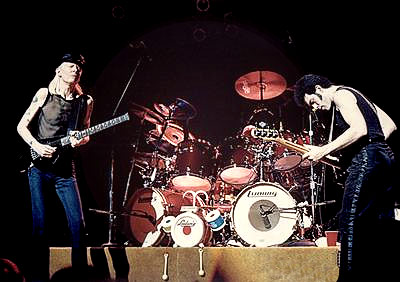Unusual: the Congress Hall of the Deutsches Museum without seating; where uniformed ushers usually relentlessly herd enthusiastic fans back into their rows, there is now freedom of movement for girls in boogie trance, for imaginary guitarists excelling on invisible guitars; space for the still numerous admirers of Johnny Winter, whose rough Chicago blues, metallic boogie, and heavy-handed rock 'n' roll have been touted in rock lexicons, liner notes, and articles for twenty years as the most authentic form of white blues. Likely, this is mainly because a tattooed albino is the closest thing a white audience can hope for from a white musician, a psychological finesse to mask their notorious inferiority complex toward both the historically exploited Black musicians and themselves.
Johnny Winter’s performance in the first thirty minutes is a masterclass for the amateur and semi-professional guitarists in the audience. With sovereign skill, he demonstrates the eternal guitar solo accompanied by bass and drums – three notes for one, the fastest shooter in the West, an artist. In doing so, the original rough stylist stands out pleasantly from those who have further coarsened and exaggerated his way of playing. Time has turned the forgery into an original that looms monolithically from the 1960s into the present, making it seem almost charming again compared to the guitar machismo of the 1970s.
After the showpiece comes the duty: Johnny Winter plays a typical Johnny Winter concert, featuring Long Tall Sally and Jumpin' Jack Flash. The pounding boogie chases the dull rock 'n' roll, and the audience is treated as if they're being taken for fools and are subsequently dismissed as such. That would have been it if Johnny Winter hadn’t brought along one of the most influential rock musicians of the last three decades to Europe: Dr. John, aka Mac Rebennack, from New Orleans, one of the few musicians from the Crescent City who managed—and wanted—to popularize the rich, though relegated, inner-city music culture of New Orleans in the U.S.
In the late 1960s, he was the Zu Zu Man, the Gris-Gris Man, the Voodoo Man, whose Afro-American religion and familiarity with drugs earned him cult status during the psychedelic frenzy of the hippie era. He was a teacher to Mick Jagger and Eric Clapton when it came to funk, Caribbean music, and the fusion of Black musical styles with rock music. On a local level, he helped push for the broader recognition of Voodoo as a religion. The last few years brought us the solo pianist in the tradition of Professor Longhair, the Thelonious Monk interpreter, the rapper, and now the blues-rock sideman, Dr. John.
In the opening act for Johnny Winter, he presented second line piano, boogie-woogie, rhythm and blues to Winter’s fans and a few dozen Mac Rebennack devotees – acoustic music before the thunder of amplified blues. How risky, how beautiful, how successful! And when Dr. John joined the Johnny Winter Trio, turning it into a quartet after about an hour, it was his two songs, You Lie Too Much and Walk on Gilded Splinters, that made listening worthwhile. Dr. John’s rough, solemn voice put Winter’s croak in its place, and the slightly louder-mixed electric piano effortlessly brought the lightness of New Orleans music into Winter’s simplistic blues style.
— Karl Bruckmaier











